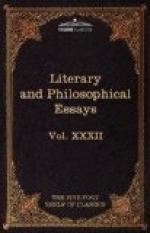In the midst of these dreams there appears with a surprising fidelity to truth the feeling for the picturesque in Polar voyages,- -the transparency of the sea, the aspect of bergs and islands of ice melting in the sun, the volcanic phenomena of Iceland, the sporting of whales, the characteristic appearance of the Norwegian fiords, the sudden fogs, the sea calm as milk, the green isles crowned with grass which grows down to the very verge of the waves. This fantastical nature created expressly for another humanity, this strange topography at once glowing with fiction and speaking of truth, make the poem of St. Brandan one of the most extraordinary creations of the human mind, and perhaps the completest expression of the Celtic ideal. All is lovely, pure, and innocent; never has a gaze so benevolent and so gentle been cast upon the earth; there is not a single cruel idea, not a trace of frailty or repentance. It is the world seen through the crystal of a stainless conscience, one might almost say a human nature, as Pelagius wished it, that has never sinned. The very animals participate in this universal mildness. Evil appears under the form of monsters wandering on the deep, or of Cyclops confined in volcanic islands; but God causes them to destroy one another, and does not permit them to do hurt to the good.
We have just seen how, around the legend of a monk the Irish imagination grouped a whole cycle of physical and maritime myths. The Purgatory of St. Patrick became the framework of another series of fables, embodying the Celtic ideas concerning the other life and its different conditions. [Footnote: See Thomas Wright’s excellent dissertation, Saint Patrick’s Purgatory (London, 1844), and Calderon’s




